This article has been submitted by wardrobedoorsdirect.co.uk
How to fit DIY sliding wardrobe doors between uneven walls
Would you like to transform your bedroom, or some other space, with beautiful sliding wardrobe doors but face the problem that your walls are uneven? Here is how to overcome the problem of uneven walls enabling you to get the quality sliding wardrobe doors that you desire.
Measure the opening between your walls carefully in 3 places for both height and width. If the measurements vary then you have the problem of uneven walls. It's a problem but by no means impossible. It just takes a little more effort to get your dream wardrobe.
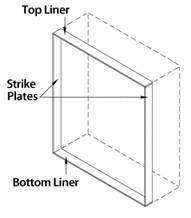 To overcome the unevenness you will need to construct a frame. The best way of doing this is by using strike plates on the walls and liners on the floor and ceiling. This frame will ensure the doors will be level, ease fixing, and increase stability of the finished wardrobe. Strike plates and liners are strips of wood or melamine faced chipboard (MFC) used to frame the doors - we recommend strike plates and liners should be at least 18mm thick. (Note: For installations over carpet or where carpet is going to be laid it is also best to use the liner).
To overcome the unevenness you will need to construct a frame. The best way of doing this is by using strike plates on the walls and liners on the floor and ceiling. This frame will ensure the doors will be level, ease fixing, and increase stability of the finished wardrobe. Strike plates and liners are strips of wood or melamine faced chipboard (MFC) used to frame the doors - we recommend strike plates and liners should be at least 18mm thick. (Note: For installations over carpet or where carpet is going to be laid it is also best to use the liner).
The Liners
Measure the floor and ceiling opening and cut your liners to size. Use a spirit level and pieces of packing to level up the liners against your ceiling and floor. It is essential that the bottom track is perfectly level to ensure smooth running of the doors. Carefully mark the position of your packing material as you will need to put them back in the same position when fixing.
Fixing the Liners
Drill 5mm holes centrally in the width of the liners, approximately 150mm from each end and space out the remaining screw holes evenly at a maximum of 500mm centres. Include drill points so as to secure the packing material as necessary. Countersink the screw holes to allow the top and bottom tracks to be fitted flush.
Double check all levels before final fixing
Fix the bottom liner (and packers) to the floor with countersunk screws, make sure that it is tight against the surface or have tight packing behind to fill any gap to avoid distorting it. Ensure the screw heads finish flush with the face of the liner.
Repeat with the top liner ensuring that it is directly above the bottom liner, be sure to use the appropriate fixing plugs depending upon whether the ceiling is lath and plaster or plasterboard.
The Strike Plates
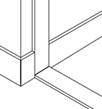 If you have coving or skirting board, you can either position the strike plate flush with it or as per the diagram remove a section and slide the strike plate in.
If you have coving or skirting board, you can either position the strike plate flush with it or as per the diagram remove a section and slide the strike plate in.
Measure the strike plates to the internal height of the frame, your strike plates will sit on top/underneath of the liners. Mark where you will cut the strike plates. Before cutting, place masking tape along the cut lines. This will prevent the surface from chipping and ensure a smooth professional finish.
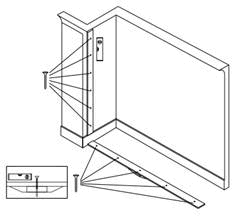 Position the strike plates against your wonky walls. Check with a spirit level that they are vertical and then use packers as necessary to fill any gap to ensure they are plumb. Carefully mark the position of your packing material on the wall as you will need to put them back in the same position when fixing.
Position the strike plates against your wonky walls. Check with a spirit level that they are vertical and then use packers as necessary to fill any gap to ensure they are plumb. Carefully mark the position of your packing material on the wall as you will need to put them back in the same position when fixing.
Fixing the Strike Plates
Drill 5mm holes centrally in the width of the strike plates, approximately 150mm from each end and space out the remaining screw holes evenly at a maximum of 500mm centres. Include drill points so as to secure the packing material as necessary.
Double check all levels before final fixing.
Secure one strike plate to the wall with screws using appropriate type wall plugs, make sure that the plate is tight against the surface or has tight packing behind filling any gap to avoid distorting it. Ensure the screw heads finish flush with the face of the liner. Repeat with the second strike plate.
For a neater finish on the plates place cover caps over the screw heads.
With the frame in place check your measurements again to make sure that everything is square and level. Make any final adjustments as necessary. You should now, in effect, no longer have uneven walls, floor or ceiling, but a nice straight solid frame to fit yours doors in.
You can use caulk or filler to fill small gaps between the strike plates and walls (or liners and ceiling/floor). Use quarter beading to hide large gaps.
Fitting the door tracks
Cutting the tracks - carefully measure the width of the top of your opening. Cut the top track to 2mm less than that measurement with a hacksaw. Repeat for the bottom track.
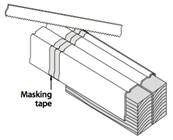 If the track bends when you start to cut it you can try to add some rigidity and support for cutting by inserting wood blocks into each channel. For a professional finish, prevent the saw blade from skidding by wrapping masking tape around the track. It also makes it easier to mark the position for cutting. Carefully remove the tape afterwards.
If the track bends when you start to cut it you can try to add some rigidity and support for cutting by inserting wood blocks into each channel. For a professional finish, prevent the saw blade from skidding by wrapping masking tape around the track. It also makes it easier to mark the position for cutting. Carefully remove the tape afterwards.
Fix the top track to the top liner.
To ensure the correct positioning of the bottom track use a plumb line from the front edge of the top track and mark three points on the bottom liner. Draw a straight line through these three points using a rule. Position the bottom track to the line and fix it in place.
Fitting the sliding wardrobe doors
With the top and bottom tracks in place you are ready to install the doors. Don't underestimate the weight of them. Get another person to help you lift and install the doors. You don't want any mishaps resulting in injury or damage to your brand new sliding doors.
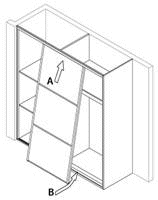 Install the rear door(s) into the top track first (A). Tilt each door and fully insert the top of the door into the rear channel of the top track. Taking care not to damage the bottom rollers, align them with the bottom track and slowly lower the door, letting the rollers snap into the track grooves (B).
Install the rear door(s) into the top track first (A). Tilt each door and fully insert the top of the door into the rear channel of the top track. Taking care not to damage the bottom rollers, align them with the bottom track and slowly lower the door, letting the rollers snap into the track grooves (B).
Repeat the process with the front door(s), using the front channel and front bottom track.
Frequently the bottom rollers are set to the lowest position so you may have to adjust these to raise the doors up. If the doors are set to the lowest position take care not to scratch the bottom track when testing the slide.
Finally make sure the doors and tracks are positioned parallel and level. Check both doors travel smoothly along the entire width. Most quality sliding wardrobe doors allow for fine tuning by adjusting the height of the rollers.
There you have it; beautifully straight sliding wardrobe doors on uneven walls.
Wardrobe Doors Direct have a great choice of styles and everything you need to design and DIY fit made to measure sliding wardrobe doors between both even and uneven walls.
You can order Melamine strike plate and liners in white, oak, beech, silver, wenge, black, dark walnut or maple along with your sliding doors from Wardrobe Doors Direct.

